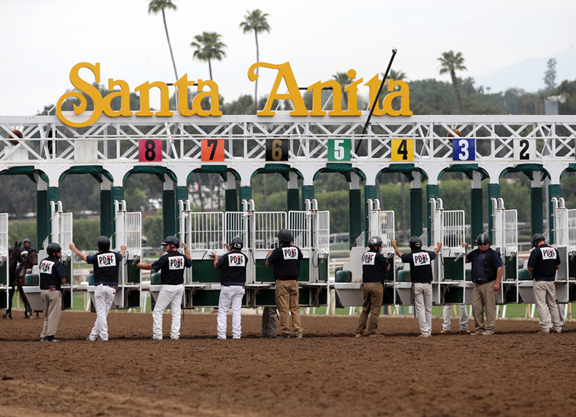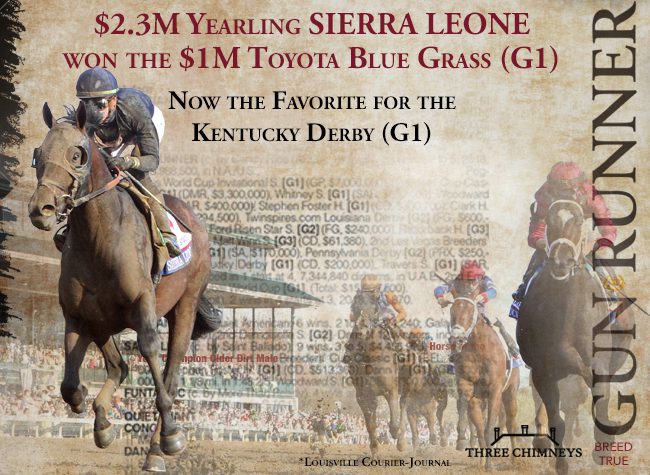By Dan Ross
Last week, a Santa Anita press release had the misfortune of arriving amid the squall of a busy news cycle.
In a nutshell, the release shared this not insignificant titbit: The track had wrapped a 16-day race meet, and a one month and 20-day training period, with zero fatalities. Since the beginning of the winter/spring meet last December, there have been five racing fatalities–zero on the main dirt track–from 5,069 individual starts.
The resulting ratio for the year of an average of 0.98 fatalities per 1,000 starters made Santa Anita “currently the safest racetrack in the nation,” according to the release. The national fatality rate is 1.53 per 1000 starts.
This is quite the reversal from 18 months prior, when Santa Anita was dubbed a “death trap.” Last year at the facility, the fatality rate was 3.01 per 1000 starts.
As it was, the news disappeared somewhat into the ether–but not by those at the front line.
“It is great to see what we're doing, and what's being done, that there are positive results,” said racetrack veterinarian Jeff Blea, past president of the American Association of Equine Practitioners.
The news also followed on the heels of another successful Del Mar summer meet where the facility saw only one racing fatality for a ratio of 0.42 per 1000 starts, and two training fatalities.
Stepping back to look at the year thus far through Oct. 28, California as a whole is operating at a rate of 1.64 fatalities per 1000 starts (including Quarter Horse starts). Over the 2019-2020 fiscal year–the basis of the California Horse Racing Board's (CHRB) annual reports–the state-wide fatality rate was 1.4 fatalities per 1000 starts (including QH starts). It should be noted that Quarter Horse deaths constitute a disproportionate percentage of overall fatalities in the state.
Zeroing in on Los Alamitos–the subject of an emergency CHRB meeting in July due to a spike in catastrophic injuries–the facility concluded its two-week day-time summer meet with zero Thoroughbred racing and training fatalities.
“It would be an understatement for me to say that Los Alamitos has doubled its efforts because it's done more than that,” said Jack Liebau, vice president of the Los Alamitos Racing Association, of the safety reforms the track has instituted since July. Indeed, since that emergency meeting, there has been one Thoroughbred and five Quarter Horse racing fatalities, and zero training fatalities, according to the CHRB.
Of course, none of this is playing out in a vacuum, with trainers, breeders and owners in California operating under what California Horse Racing Board (CHRB) medical director Rick Arthur says is the most stringent regulatory environment in the country–in some regards, globally. Economic constraints are an obvious tradeoff.
Earlier in the year, the TDN reported how reduced horse inventory at Santa Anita had a knock-on effect over field size and handle, while some backstretch workers had even turned to Uber-driving to supplement their income–and all this before the pandemic hit.
“Everybody is glad that the heat is off us,” said Eoin Harty, president of the California Thoroughbred Trainers (CTT). “Whatever protocols have been implemented are obviously working.”
But the COVID crisis has only heightened economic pressures on trainers, he added.
“The biggest concern going forward is the purse funds, how we generate them, how we elevate them.” Harty said. “It's hard enough to win a race in California as it is,” he added. “And when you can potentially go somewhere a little easier for a lot more money, it becomes very inviting.”
Nor should the industry rest on its laurels when it comes to the downward trend in fatalities, cautioned Blea.
“They're racehorses and they're athletes, and because they're athletes, they're always at risk of getting hurt,” he said, emphasizing the element of unpredictability that working with horses brings. “Anything can happen. It can happen out in the field, in a stall. It can happen out on the racetrack.”
“Fractures Just Don't Happen Overnight”
The arc of regulatory change in California these past 18 months has been broadly encompassing: tougher scrutiny during both training and race-day, more rigorous pre-race examinations, stricter medication policies, whip use reform, and greater public transparency of even low-level medication violations.
Consequently, many struggle to identify solitary reasons behind the decline in fatalities–a multifactorial issue as it is. Rather, they look at the gestalt of a wholesale cultural shift.
“You can have the greatest procedures and protocols, but if you don't get stakeholder buy-in, it's not worth a whole lot,” said Josh Rubinstein, president at Del Mar Thoroughbred Club, where the track's high fatality rate during the summer of 2016 precipitated a comprehensive set of successful safety reforms.
“There's been a change in culture, in a good way,” Rubinstein added. “For us, it's been four years of continued improvement in safety.”
That said, some noted individual factors peculiar to the California experiment. Tom Robbins, Del Mar's executive vice president of racing and industry relations, is quick to sing the praises of track superintendent Dennis Moore, whose expertise is shared among various Southern California tracks.
“Dennis came on board early 2017,” said Robbins, “and was given the green light to do anything that he felt was important to do.”
Santa Anita management emphasize a fairly new position: That of the “vet monitor” working alongside the “secondary vet” who scrutinizes the horses–typically from the finish line–on raceday.
The secondary veterinarian's view of the horses on raceday is fairly limited, explained Amy Zimmerman, senior vice president and executive producer at Santa Anita. “As the horse goes around the backside, they lose sight of them. The only place they're able to watch them is on the big screen monitor which is just showing one horse at a time.”
The new vet monitor, however, has access to feeds from the various cameras around the track, all of which are hooked up to a series of monitors in one room.
“What we did is mirror what they have in a TV truck,” Zimmerman said.
If the vet monitor spots a potential problem, they can request an isolated–and non-public–camera feed on a specific horse, and then if necessary, ask the on-track veterinarian to conduct an evaluation of that horse, Zimmerman added.
“Every person has only two sets of eyes, and they can only look at one thing at a time,” said Zimmerman, the brainchild of the additional monitor. “This allows more eyes on safety from people who are qualified to do that.”
Indeed, the vet monitor has a basis of comparison for many of the horses having also been involved in the pre-race examination program.
“It also is giving them the ability to watch the horses on the gallop out,” Zimmerman added. “If they don't like the way a horse finishes, they can go back and look at [the horse] the next day or two days later and see how it really came back.”
According to G.D. Hieronymus, Keeneland's director of broadcast services, the track will have a similar position in place “hopefully” by the spring. “This is something that all tracks need,” he said.
Many experts will say, however, that a problem has gone too far if a state vet scratches a horse the day of a race. Which is where Santa Anita's two new imaging technologies–the Longmile Positron Emission Tomography (MILE-PET) Scan machine and standing magnetic resonance imaging (MRI) unit–appear to have played no small part.
“Disease is a process–fractures just don't happen overnight,” said SoCal-based private veterinarian Ryan Carpenter, who earlier this year said that these modalities have “100% saved lives.”
“When you can understand bone remodeling and you can understand the disease taking place over time, then you have the ability to intervene before the fracture occurs. That's where our ultimate goal is as veterinarians,” Carpenter said. “And that's what the PET scan and MRI has helped us to do.”
Carpenter explained that prior to the arrival at Santa Anita of these two units, he and the other researchers expected to conduct only one or two scans a week.
“I know they've got four MRIs to do today and tomorrow,” he said, earlier last week. In all, they have conducted 164 PET and 89 MRI scans thus far.
“We're doing more of them than we ever imagined,” he said.
Challenging Year
What isn't imagined for many trainers and owners in California–especially those operating at the lower end of the economic ladder–is the weight of the additional constraints, financial and otherwise, that the past 18 months have introduced to operating a barn in California.
“This has been a very challenging year for everybody,” said Arthur, admitting that some of the measures–such as the medication restrictions during training–constitute a “paradigm” shift across the backstretch community.
“I don't know any other state that's currently regulating medications during training,” said Arthur. As such, “There is a transition period from the way they used to do things to the way they have to do things today,” he added.
During the 2019-2020 fiscal year, 0.2% of work bloods–required for removal from the vet's list–resulted in a Class 1, 2 or 3 medication positive, and 2.6% resulted in a lesser Class 4 or 5 finding. During Out-of-Competition testing, 1.4% of the samples had a Class 4 or 5 positive.
“A large number of our findings would not be a violation in other states,” Arthur explained. “And those finds are not a reflection of drug or medication abuse, but really how tightly California regulates drugs and medications.”
Have some of the reforms gone too far?
“I think it is potentially unfair,” he said, of a statutory change to come into effect Jan. 1 whereby drug positives confirmed through split sampling–or even earlier if the licensee declines to request split-sample testing–will be posted on the CHRB website before complaints are issued. “Horseracing is a very competitive business for trainers and owners. I think a lot of people jump to conclusions.”
While the reforms had already loosened the soils around the state industry's economic roots, the pandemic has taken a hacksaw to the trunks, with a marked shift towards ADW platforms that, when compared to wagering at brick and mortar facilities, funnels fewer funds into the state's purse account.
As the TDN reported earlier in October, compared to a comparable eight-month period in 2018, the number of races this year has declined 30%, and while the overall handle has declined 18.8%, purse revenues have dropped more than 26%.
“The cost of doing business is going up and the purses available to make sense of the economic model are not commensurate with the rate of inflation of horse ownership,” said Eclipse Thoroughbred Partnerships president Aron Wellman.
And while Wellman said that he “applauds the powers that be for putting out the fires,” given the harsh economics of running a solvent operation in California at the moment, some of the measures, he added, are a “little too extreme.”
Between the reforms and the cost of doing business, “It's a balancing act,” said Wellman.
For a number of other stakeholders interviewed for this story, the fix is simple: Uniform standards across all states so that trainers and their owners are operating on a level playing field.
In that regard, “what you're seeing with federal legislation, and other states such as New York and Kentucky–they're going to be implementing the same things as we have here,” said Rubinstein, pointing towards the Horseracing Integrity and Safety Act, and the proposed whip reforms in New York.
“As challenging as it has been in California,” Rubinstein added, “we feel like, as a group we're doing the heavy lifting early on here, and we're ecstatic that others are attempting to catch up.”
Not a subscriber? Click here to sign up for the daily PDF or alerts.






